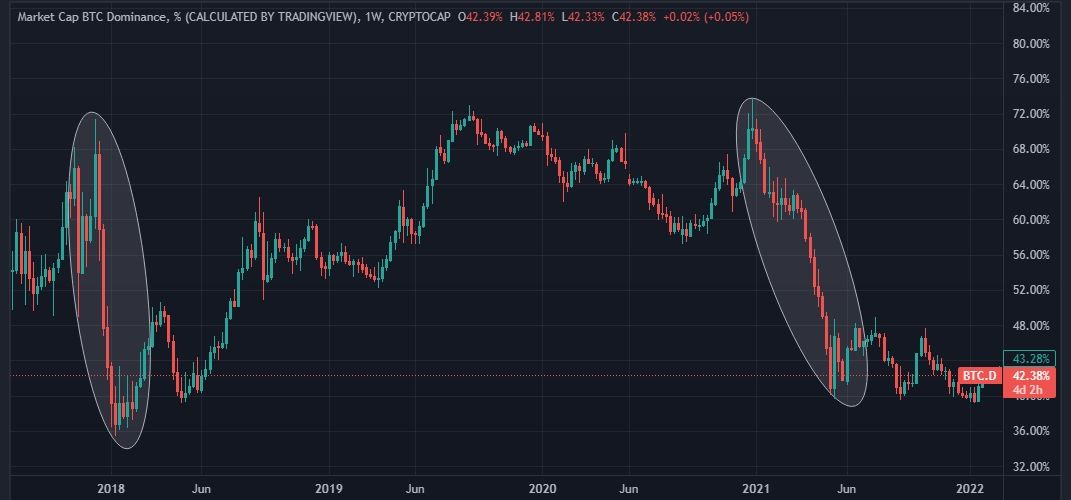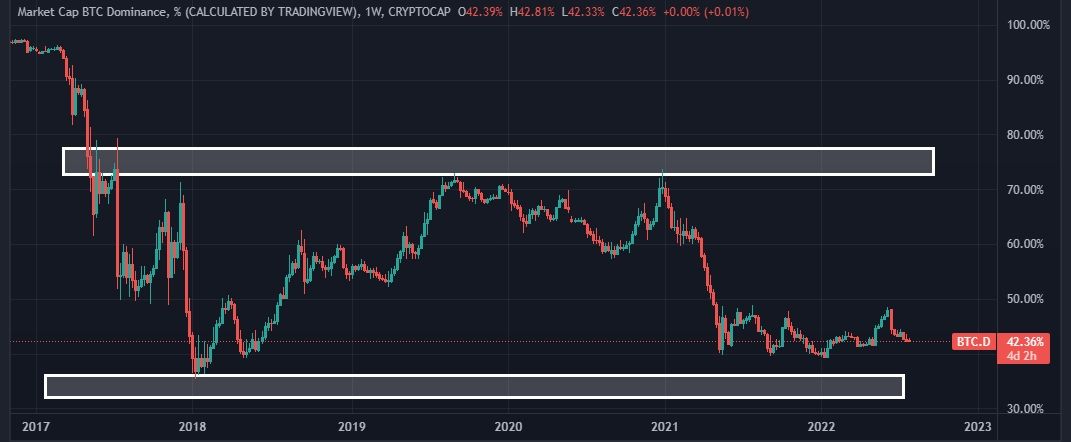The cryptocurrency market is highly volatile, making it a potentially risky investment. As a result, traders and investors are increasingly devising different tools and indicators to track market trends to make the right trading decisions.
One of these tools is the “Bitcoin dominance index.” The Bitcoin dominance index helps to analyze different market conditions to determine the stronger market trend between Bitcoin and altcoins.
In this article, we’ll describe Bitcoin dominance, the factors that affect it, and how you can use it to make better trading decisions.
What Is Bitcoin Dominance?
Bitcoin dominance, or BTC dominance, is the measure of how much of the total value of all cryptocurrencies is made up of Bitcoin. Its basic principle is that if the dominance of BTC increases, the value of altcoins will decrease. Conversely, if the dominance of BTC decreases, the value of altcoins will increase. BTC dominance is also called the Bitcoin dominance index and the Bitcoin dominance ratio.
The level of Bitcoin dominance is determined by comparing the total market capitalization of Bitcoin to the total market capitalization of all other cryptocurrencies combined.
The term crypto market capitalization refers to the total market value of cryptocurrencies. The market capitalization of a cryptocurrency is determined by multiplying the total number of coins in circulation by their current price.
The price of a crypto token is not the only way to determine its value. Investors look at market capitalization to get a bigger picture and to compare the value of different cryptocurrencies. As a key statistic, market capitalization can show how much the price of a cryptocurrency could grow and whether or not it is safe to buy compared to others.
3 Key Factors Affecting BTC Dominance
So, how does BTC’s strength relate to other cryptocurrencies? What affects BTC dominance?
1. Altcoins Usage Increase
Bitcoin was created to replace fiat currencies and be a common currency for transferring value. On the other hand, many altcoins go beyond being an exchange system as they are also used in major projects, including gaming, security, art, and many more DeFi services. As a result, Bitcoin’s market dominance decreases as altcoins become more widely adopted.
2. Stablecoin Use Increase
We all know that the cryptocurrency market is volatile. To deal with this, many people have started looking into stablecoins, a type of altcoin. A stablecoin is a cryptocurrency whose value is pegged to another asset class to remain stable, like fiat currency, gold, etc.
With stablecoins, crypto investors don’t always have to convert their money to fiat currencies to lock in their profit. Instead, they can convert it to stablecoins. Moving your funds from the volatile Bitcoin to stablecoins reduces BTC dominance.
3. New Cryptocurrencies Launch
Many more coins are being introduced into the market, attracting more users and investors. Some of these coins attract investors and developers in a short time. In their bid to gain market relevance, the project team carry out activities to make the altcoin more valuable. Some altcoins get hyped up on social media, making investors jump into the price pump for the possibility of making quick money. These activities also reduce Bitcoin’s dominance.
There are many ways to make money faster with altcoins than with Bitcoin. Bitcoin’s price is already high, and compared to other cryptocurrencies, it is more stable. Many people are investing in altcoins to profit from more volatile and dramatic market moves.
2 Ways To Use BTC Dominance in Trading
Is it possible to use BTC dominance in your crypto trades?
Using BTC Dominance To Determine Altcoin Season and Other Price Trends
The term “altcoin season” describes a period when the price of alternative cryptocurrencies surges compared to Bitcoin for several weeks or months. This occurrence typically occurs when the price of Bitcoin stalls following a significant rise and investors transfer their profits to other coins, kicking off a new bull market for altcoins.
You can spot an altcoin season using the TradingView Bitcoin Dominance Index. The index compares the market capitalization of Bitcoin to that of other cryptocurrencies. The result can be used to determine if it’s better to invest in Bitcoin or if altcoins have a stronger trend.
The picture above shows that in 2018 and 2022, BTC’s market share dropped by a lot. This long fall in BTC’s dominance could indicate an altcoin season, which could be a good time to put more money into altcoins.
Using BTC Dominance to Trade at Market Extremes
Between 2017 and 2021, BTC’s market share went as high as 75% and as low as 35%. At the time of writing, it is less likely that BTC market capitalization will go above 75% soon. However, when the ratio gets close to 75%, it might be time to expect a Bitcoin price fall. Also, a ratio close to or below 35% shows that BTC’s dominance is weakening, and it could also mean that a price movement in the opposite direction is imminent. Of course, this is just speculation—you’ll have to make your own decisions regarding your crypto investments!
The BTC dominance may not frequently reach those highs and lows. However, when it reaches them, it would offer investors good trading opportunities.
BTC Dominance Cannot Be Used as a Stand-Alone Indicator
The BTC dominance is a great way to figure out the market trend since it shows how strong a Bitcoin trend is compared to other cryptocurrencies. It can give you more information about the changing markets and when to adjust your strategies. However, this strategy doesn’t guarantee that Bitcoin and other altcoins will move as predicted. It should only be used as a guide, along with other indicators and strategies.
Furthermore, more altcoins will be created, and the Bitcoin dominance ratio might become inconsequential as they gain market share. But until that happens, it would still be a good way to find out some market trends and identify trading opportunities.
This is not financial advice. If you’re interested in any form of investment, you should approach a licensed financial adviser who can give you the best advice based on your needs and risk appetite.




